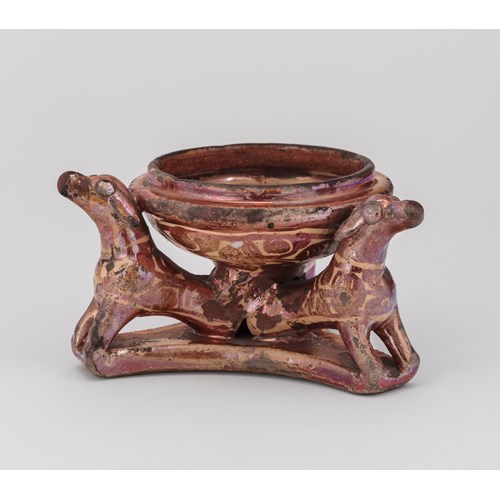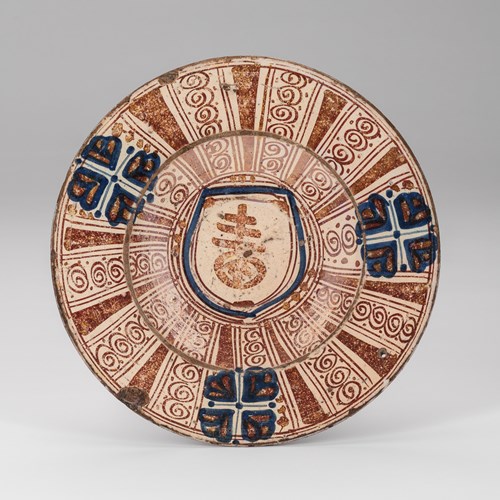Marketplace
Rare Ottoman Hançer
This is one of a series of daggers looted at the Battle of Vienna in 1683, sometimes referred to as Türkenbeute (Turkish loot). Its owner was a member of the illustrious Kaunitz-Rietberg family, who were advisors and friends to the Habsburg family throughout the 17th and 18th centuries. As such, they had the ear of European monarchs, making them one of the most important families in Austro-Hungary.
Count Ernst Franz Karl Rudolf von Kaunitz-Rietberg was appointed General of the Guards Cuirassiers in Bohemia. In this role, he would have fought Ottomans during the First Kuruc Uprising in 1672, where his regiment was honoured, and the Battle of Vienna in 1683. It is likely that this dagger was booty from one of these battles.
The lightly curved, double-edged watered-steel blade is ornamented on both sides at forte with koftgari inlay. Three hammered dots on the blade suggest that there was more decoration which has now been lost. The hilt, though of the characteristic waisted form, is rare in the choice of material; silver gilt engraved and inlaid with niello. Most Ottoman hançers have smooth hilts of horn or semi-precious stone for the tactility. At the slimmest point of the hilt, a row of dots and tiny lotus buds are engraved into the silver gilt. The pommel is set with a red carnelian, flanked by two small turquoises.
The wooden scabbard is coated with silver gilt and decorated with niello. Echoing the silver dots of the hilt, a band of five small turquoises and four small carnelians are applied to front of the scabbard at the throat. The front of the scabbard is much more densely ornamented, etched with vegetal ornamentation and niello bluebells. The reverse, fitted with a belt loop, is more sparsely decorated with flowers and leaves.
A large fan pattern can be seen on both sides of the scabbard. This serrated palmette motif represents a carnation and was commonly used in Iznik ceramics and textiles. Imperial velvet panels decorated with the same fan-carnation motif can be dated to c. 1600.1 However, this appears to be the only surviving early 17th century example of Ottoman arms and armour decorated with the iconic fan-carnation motif.
A number of similar hançers are held in the Baden State Museum as part of the famous Karlsruher Türkenbeute. A short dagger (accession no. D 271) has a waisted nephrite handle, its pommel set with a ruby. It has a plain, lightly curved watered steel blade. The scabbard is entirely covered with silver gilt, and richly decorated with vegetal ornamentation, enhanced with niello. Daggers G 809, D 269, and D 272 are all of the same form and roughly the same size as the present example, with silver gilt and niello sheaths.
n.b. accession nos are clickable links.
1 Atasoy, Nurhan et al. The Crescent & the Rose: Imperial Ottoman Silks and Velvets. London: Azimuth Editions, 2001. pp 316-317.
Count Ernst Franz Karl Rudolf von Kaunitz-Rietberg was appointed General of the Guards Cuirassiers in Bohemia. In this role, he would have fought Ottomans during the First Kuruc Uprising in 1672, where his regiment was honoured, and the Battle of Vienna in 1683. It is likely that this dagger was booty from one of these battles.
The lightly curved, double-edged watered-steel blade is ornamented on both sides at forte with koftgari inlay. Three hammered dots on the blade suggest that there was more decoration which has now been lost. The hilt, though of the characteristic waisted form, is rare in the choice of material; silver gilt engraved and inlaid with niello. Most Ottoman hançers have smooth hilts of horn or semi-precious stone for the tactility. At the slimmest point of the hilt, a row of dots and tiny lotus buds are engraved into the silver gilt. The pommel is set with a red carnelian, flanked by two small turquoises.
The wooden scabbard is coated with silver gilt and decorated with niello. Echoing the silver dots of the hilt, a band of five small turquoises and four small carnelians are applied to front of the scabbard at the throat. The front of the scabbard is much more densely ornamented, etched with vegetal ornamentation and niello bluebells. The reverse, fitted with a belt loop, is more sparsely decorated with flowers and leaves.
A large fan pattern can be seen on both sides of the scabbard. This serrated palmette motif represents a carnation and was commonly used in Iznik ceramics and textiles. Imperial velvet panels decorated with the same fan-carnation motif can be dated to c. 1600.1 However, this appears to be the only surviving early 17th century example of Ottoman arms and armour decorated with the iconic fan-carnation motif.
A number of similar hançers are held in the Baden State Museum as part of the famous Karlsruher Türkenbeute. A short dagger (accession no. D 271) has a waisted nephrite handle, its pommel set with a ruby. It has a plain, lightly curved watered steel blade. The scabbard is entirely covered with silver gilt, and richly decorated with vegetal ornamentation, enhanced with niello. Daggers G 809, D 269, and D 272 are all of the same form and roughly the same size as the present example, with silver gilt and niello sheaths.
n.b. accession nos are clickable links.
1 Atasoy, Nurhan et al. The Crescent & the Rose: Imperial Ottoman Silks and Velvets. London: Azimuth Editions, 2001. pp 316-317.
More artworks from the Gallery








